The State of Sports in 2024
Quadrennial events like The Olympics, Paralympics, EUFA Euros 2024 are adding to the existing list of annual mega sports events like The Super Bowl, Tennis Opens, Golf Masters, and more. Throw into the mix the regular seasonal sporting program with games, matches, and events in the Premier League, Formula One Racing Calendar, NFL, NHL, Basketball and so much more, you’ve got a huge year of sport coming your way.
But what does this all mean for the FMCG industry? We’ve identified the 5 key trends for 2024’s year of FMCG and sport that will impact the industry and how brands can maximize the opportunities that sports events and their celebrations present.
Trend One:
Brand Participation
The first way sporting events directly impact the FMCG industry is via brand participation from partnerships, sponsorships and collaborations with events, teams or individual athletes. From the infamous Super Bowl Ad spots, which this year cost brands up to $7 million per 30 second slot, to smaller social media campaigns on platforms like Instagram and TikTok, brands turn to a variety of channels with a variety of budgets to get sport-sponsorship messaging in front of shoppers.
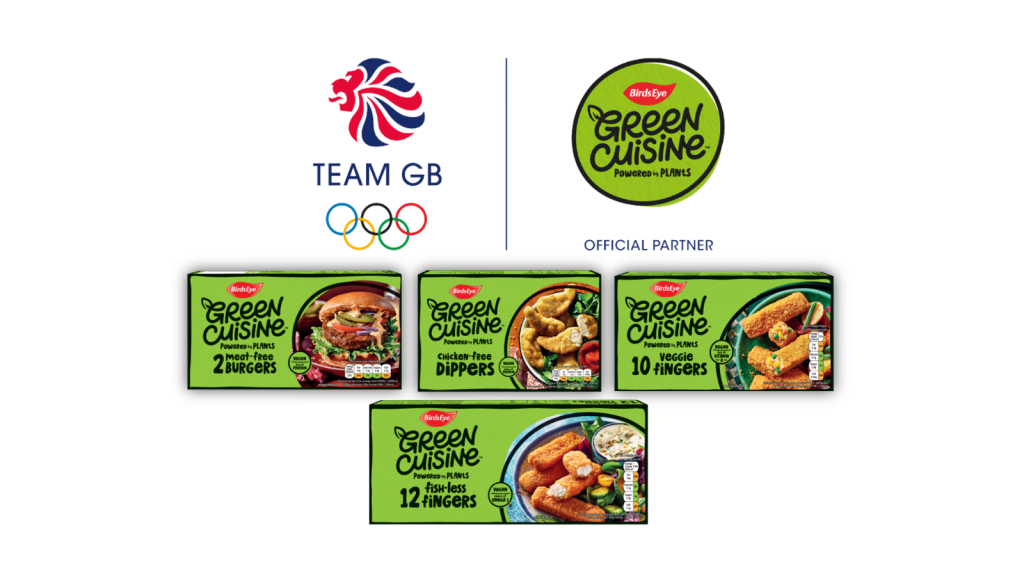
In the UK, plant-based grocery brand Green Cuisine has partnered with Team GB ahead of the 2024 Paris Olympic Games, launching the “Get Set to Go Green” educational campaign, utilizing sport and athletes to further their mission of democratizing plant-based diets across the UK.
We spoke to Green Cuisine to find out why sports partnerships are important to the brand and how they intend to tell their brand story during this pivotal year of sport. Tory Westwood, Green Cuisine Marketing Lead, says “Following a successful partnership with Team GB during the Tokyo 2020 Olympic Games, we’re proud that Green Cuisine will once again be an Official Partner of Team GB ahead of the Paris 2024 Olympic Games, furthering our mission to make plant-based foods accessible to all. The collaboration will see Green Cuisine helping to educate the nation on the nutritional benefits of plant-based food, as well as supporting Team GB’s drive for environmental sustainability.”
Green Cuisine recognize the significance of public awareness and positive attitude toward Team GB, noting that 65% of the British Public are proud to support Team GB and believe it to be a positive influence in society. By forging a partnership, their brand messaging and products are now aligned with the positivity surrounding Team GB.
“Our desire is to create a partnership that increases brand awareness and overcomes key consumer barriers through promoting the taste & health credentials of Birds Eye Green Cuisine through recognized Team GB athletes.”
Tory Westwood, Green Cuisine Marketing Lead
To generate awareness of the campaign and tell the brand story across multiple channels, Green Cuisine has created a strategy that encompasses all aspects of the shopper journey, including updating packaging and digital content.
“We plan to tell our story through multiple channels, mostly instore directly with Shoppers through our on-pack promotion and instore shopper marketing communications. However, we also have a 3-part digital content series going live with Team GB from January which will be helping to educate around the nutritional benefits of plant based and all about living a sustainable lifestyle.”
Find out more about Green Cuisine’s partnership with Team GB by reading the full Q&A
The opportunity of reaching new demographics and audiences:
Yogurt Brand, Müller, have turned to a sports-star for a multichannel campaign featuring their rice products. Declan Rice, West Ham and England Team football star has partnered with Müller in a multi-million-pound deal to promote the brand’s Müller Rice product range, utilizing the star’s name and its popular football chant. The “Rice, Rice Baby” campaign leverages an athlete’s popularity to market products in front of new audiences, indirectly linking, and tapping into, the audiences for both the Premier League and other football events tied to the England Team.
Toby Bevans, Strategy and Marketing Director for Müller Yogurt and Desserts states, “By working with Declan, we hope to engage with and entertain new audiences, bringing the enjoyment of Müller Rice to those looking for a tasty on-the-go snack.”
The campaign capitalized on a unique opportunity with the star’s name to completely reposition the target market for their range of products. By utilizing a widely-recognized figure among sports fans, the campaign resonates with a different demographic of shoppers.
Transforming successful collaboration into sales
Whichever form these collaborations take, ensuring that shoppers can find your products easily is vital. This means ensuring your messaging aligns across the omnichannel from your social media posts to your instore activations and your product description pages on retailer websites. A shopper should be able to easily find your product online after seeing a print advert, television ad, or social media post, whether that be for further research or eventually purchase. This means enriching product pages with rich content and ensuring that basic data and imagery is high quality and encourages shoppers to connect and purchase.
Products connected to sporting events are also higher on shopper priorities than usual. According to a survey from Budweiser Brewing Group UK and Ireland, 68% of England fans believe that during events like the UEFA European Championship, retailers should stock “official sponsor” brands, while 55% of shoppers are more likely to opt for “official sponsor” brands over their usual beer choices. It is essential that brands that have invested in partnering and sponsoring are available to purchase online, instore and across the omnichannel.
1. Questions to ask:
- If your brand is sponsoring, partnering or collaborating with a sporting event, are your key messages aligned across the multiple touchpoints within the omnichannel?
- How has partnering, sponsoring or collaborating with a sport event or team impacted your brand messaging?
- Do you have new packaging you need to update images and data for across your online channels and will you have it online in time for launch?
- Are your products discoverable to shoppers learning about your brand from these sports collaborations?
Trend Two:
Health, Wellness, and Lifestyle Trends
Snacking is synonymous with sports viewership and many reports highlight the heavy consumption of food during sports mega-events like the Super Bowl. This food often comes in the form of convenient, quick, often indulgent forms in products like burgers, fries, and beer. However, with an increase of shoppers searching for products that meet their unique and specific dietary and lifestyle needs, brands need to keep up with the demand. For example, The UK Government’s Food Standards Agency estimates that around two million people in the UK are living with a diagnosed food allergy and in the US, around 32 million Americans have food allergies, according to Food Allergy Awareness Week.
These shoppers consider specific attributes that align with their specific needs, often meaning they are willing to spend more on items that match their need states. A recent survey conducted by NIQ Brandbank uncovered that over half of respondents (54%) would be willing to pay more for ingredients that they understand, furthermore, an NIQ Survey indicates that 26% of shoppers intended to spend more within the health and wellness category as we move into the new year.
So, what are the key trends to watch as shoppers search for snacks?
NIQ Brandbank data indicates the top trends in online searches for 2023 and helps us to identify the key attributes shaping shopper purchasing decisions as we head into 2024.
For example, searches for Protein in 2023 increased by 2.7 million searches, with some search terms like “high protein” growing by 10% over the previous year. It’s therefore likely that shoppers will continue to seek out ‘high protein’ foods, especially if inspired to get involved in sports where high protein is a popular dietary and lifestyle choice to grow muscle mass and fuel long training sessions.
Other trending attributes as we head into the year of sport include terms like “Organic” and “Fresh,” highlighting another area that brands should focus on when promoting products during sporting events that lay outside the typical connotations of sport viewing snacks. With overall increased search volume for “fresh” and “organic” food, it is vital that brands that produce products in those categories are prepared ahead of this year of sport and for the influx of shoppers looking to align their specific shopper needs with their shopping for watch-party events.
This demand for healthier options can also be seen in Green Cuisine’s Partnership with Team GB, with the brand utilizing their partnership with the team ahead of the Olympics to educate shoppers about the importance of healthy eating habits and green initiatives.
“This partnership offers us a golden opportunity to highlight the benefits of a flexitarian lifestyle for the good of ourselves and the planet, and also allows us to go one step further and deliver a united sustainability strategy. With plant-based consumption set to explode to five times its current size over the next 15 years, we are committed to helping consumers and retail partners recognize the benefits of the category and educate them on its relevance and the role it has to play in the health of both the planet and ourselves.“
Tory Westwood, Green Cuisine Marketing Lead
For brands like Green Cuisine, looking to capitalize on the opportunities presented by this mega year of sport, calling-out existing product attributes like protein content, freshness, and more, is the best place to start. This can be highlighted on pack, but most importantly should be called out somewhere on your product pages across the omnichannel to maximize returns from search and ensure your products are discoverable at the point of purchase.
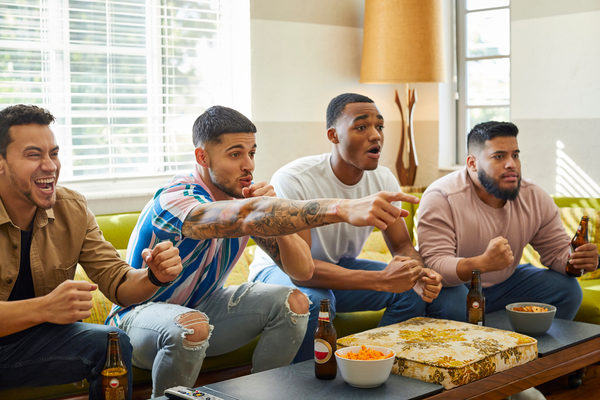
2. Questions to ask:
- Are you calling out ALL your product attributes on and off-pack to ensure your products are discoverable?
- Are you optimizing your product content to call-out your key Health, Wellness and Lifestyle attributes to connect with shoppers?
- Are you offering product variations that align with shopper needs?
Trend Three:
Last Miler and Rapid Delivery Growth
Shoppers are increasingly seeking out convenient services and solutions for their grocery needs. One of the key players in this space are last mile delivery options which have recently evolved to encompass rapid grocery delivery around the world. Players like Instacart, Deliveroo, Uber Eats, and more all offer shoppers convenient delivery and tend to have partnerships with leading sports franchises and events.
But what do these partnerships look like? And how can last milers and rapid delivery services, and the brands featured on their apps and platforms, make the most of the opportunities presented by sports events?
Last Milers, Rapid Delivery Platforms, and Event Promotions: Deliveroo
Global last-mile giants Deliveroo celebrate sporting events like the FIFA World Cup in multiple ways. Firstly, Deliveroo has previously partnered with the England Team, even sponsoring a spot on the official England Team Training Kit for the 2022 World Cup. During previous Football related events, Deliveroo riders in England were given special driver uniforms and bike bags that featured the 3 Lions badge (the England Team logo). These promotional collaborations provided both the England Team and Deliveroo with extra visibility and landed synonymity with the event in shopper minds.
Secondly, and most importantly to shoppers, Deliveroo has previously offered enticing promotions including % discounts, multibuy offers, free items, and meal deals to encourage shoppers to utilize convenience during their watch-parties and at-home celebrations.
For example, Deliveroo has even run promotions during events that see shoppers win discounts if their team score goals or earn points. In fact, during the 2018 World Cup in Russia, Deliveroo offered shoppers across their different markets the chance to win Deliveroo credit in dollars and pounds if teams scored goals during certain matches.
Last Mile and Grocery Growth
While apps like Deliveroo and Uber Eats are widely known for their vast restaurant offering and meal delivery services, recent years, sparked by the pandemic, have seen an influx of retailers and convenience stores utilizing rapid delivery services to fulfill shopper demand for convenient shopping experiences. Some retailers across the UK have even begun to launch their own rapid delivery services, for example Tesco’s Whoosh service that promises shoppers rapid delivery in as little as 20 minutes, and Asda’s Express delivery service that promises items in under an hour.
Shoppers are increasingly turning to last mile apps to source forgotten items and even fuel long watch parties with snacks and are seeking out their grocery favorites via rapid delivery. Additionally, across the UK, Deliveroo and Uber Eats now offer shoppers the ability to add grocery items to an existing meal order with zero fees, meaning now more than ever FMCG products and retailers are spotlighted in last mile apps ready for shoppers to discover and purchase.
With some events offering multiple rounds, matches and fixtures that attract viewers to watch across days, weeks and even months, mixing up the promotions and offers to connect with viewers and convert them to shoppers quickly and easily. But how can brands, retailers and last milers connect shoppers with these convenient opportunities?
Connecting the Dots: Instacart and Shoppable Advertisements
In 2023, US instant-delivery giant Instacart, partnered with AB InBev to create shoppable advertisements. Using Michelob Ultra beer products as the featured product, advertisements included QR codes that, when scanned, transported shoppers directly to a shoppable landing page in the Instacart platform. Unlike typical product advertisements, the Instacart partnership enabled shoppers to discover, research, purchase, and receive products almost instantly, removing the chance a shopper will be side-tracked during the journey to purchase.
Underneath the product listing for those in the advertisement, shoppers were also presented with a range of complimentary items from PepsiCo Brands like Frito-Lay. This encouraged shoppers to stay within the Instacart app and minimized the steps they needed to take to find more products for their Super Bowl party, providing inspiration and enabling them to discover a range of products instantly. This level of convenience is something shoppers have started to expect, and meeting shoppers with everything they need in a few clicks is essential to winning the last mile race.
In previous years Instacart has run extensive social media campaigns on platforms like Tik Tok that have secured Instacart as synonymous with game-day snacking across the US, and made it a top destination for shoppers looking for convenient snacking options on the day of events like the Superbowl.
How to maximize sales potential when more shoppers are shopping with last miler platforms
There are several key steps last milers, and brands featured on them can do to maximise sales performance during the upcoming year of sport. Firstly, shoppers need to be able to find the products they want easily. An easy step toward creating effortless product discoverability is to create convenient landing pages that feature products shoppers are looking for. Simply creating a dedicated landing page, like Instacart for their collaboration with AB InBev, means shoppers have a succinct and concise space to explore their snacking options.
Next, shoppers are likely to utilize last milers during or immediately before the event, but prior knowledge of the platform and deals available to them is essential. Spending time on dedicated campaigns to create awareness that there will be promotions, or that the last mile platforms are the number one destination for last minute items is essential so that shoppers know where to go when the time comes.
Lastly, as shoppers increase the use of last-miler and convenient delivery apps, they will come to expect the same levels of product information that they can access across the omnichannel. This means ensuring that product listings on a last-mile app feature key product information and attribute callouts that can be accessed on a typical product description page. This also means ensuring quality product imagery that is optimized for mobile as shoppers utilize last mile mobile apps.
3. Questions to ask:
- Are you tailoring your last-miler platform to link to the event?
- Are you targeting your promotions, marketing content and discounts in the right spaces?
- How are you driving engagement at certain times during the event?
- Do you have dedicated landing pages to highlight game-ready snacks and products to keep up with competitors?
- Are your last-mile product listings matching the standard of your product content across other omnichannel touch-points?
Trend 4:
Social Media Campaigns and the drive for engaging product content
By utilizing social media platforms and campaigns, companies can offer shoppers engaging and often personalized content that connects them with a product. In fact, shoppers are increasingly turning to social media for discovery and research, with 40% of Gen Z preferring social media platform Tik Tok to Google for research.
Social media offers brands the opportunity to connect with shoppers beyond the purchase of their product and can offer cheaper alternatives to sponsoring events or paying the big bucks for commercial advertising. Social media is the perfect platform for product discovery, recipe inspiration and influencing shoppers, but for brands and retailers in the FMCG space, it is essential that the personalized content and shopper experience is consistent across all touch points online, including the point of purchase.
What does a successful FMCG social media + sport campaign look like?
Look no further than the 2023 Doritos Super Bowl campaign launched on TikTok. The campaign centered around creating a viral TikTok Triangle themed dance that offered participants the chance to win an appearance in their coveted Super Bowl Commercial with stars Jack Harlow and Missy Elliot along with $5,000.
Adverts for the campaign featured TikTok dancer influencers and the custom hashtag #DoritosTriangleTryout amassed 17.5 billion views. This campaign created a fun and engaging form of user-generated advertising for Doritos, with thousands of participants sharing the brand name and connecting with friends and followers across social media. Finally, to connect shoppers with their products across the omnichannel landscape, Doritos used rich media assets including additional marketing images and promotional video content across several different retailer pages including Walmart and Target in the United State. This helped Doritos continue the engaging shopper experience across the omnichannel, from the initial discovery on social media to the final point of purchase.
Meeting evolving shopper expectations with rich media content
Consistent messaging across channels is vital when it comes to social media campaigns for FMCG products. Ensuring that product content matches the messaging found on social media, whether a shopper chooses to shop online or instore, is essential to creating trust and brand loyalty.
The addition of rich media content to product description pages can be the perfect solution for shoppers looking to explore a brand’s products on retailer platforms. We know that up to 70% of shoppers research products on mobile devices before purchasing in store. By creating strong rich media content, that links to your current omnichannel campaigns, it helps meet evolving shopper expectations set by strong social media precedents.
4. Questions to ask:
- Are the products featured in your social media campaign discoverable, in-stock and on a promotion that encourages shoppers to purchase your products?
- Could your brand create more engaging product content to enhance product pages across the omnichannel?
- Do you have assets created for social media campaigns (videos, infographics, marketing images etc.) that could enhance the product page and connect shoppers with the point of purchase?
Trend 5:
Cost of living challenges
As the cost-of-living crisis continues to impact shoppers and their spending behaviors, we are seeing more shoppers act cautiously when it comes to spending for events and celebrations around sporting events. However, as the lingering effects of the pandemic lockdowns slip further into memories, shoppers look to sports events as opportunities to gather and celebrate with family and friends.
In fact, for the 2023 Super Bowl, 82% more Americans planned to host friends and family for watch parties than in 2022. 52% planned to watch the game at home, and on-average, Americans planned to spend $115 on Super Bowl Sunday, with the average increasing to $246 for those earning 6 figures or more.
Ultimately, shoppers are looking to spend on sports events, especially for those special finals, play-offs and big-ticket games, despite reducing spend in other areas. We can expect a continuation of this trend as we head into 2024, with a return to normalcy and an increase in watch parties and gatherings, shoppers will continue to spend more on events like the Super Bowl and the Euros and NBA Playoffs.
The high demand for products during sporting events, particularly those products with a connection to an event like a certain beer brand and a certain football event (in their many combinations!), can lead to an increase in out-of-stocks. This is good news for smaller brands and those who act as alternatives to the branded featured products. It is an optimal time for product discovery.
Making your products discoverable to meet shopper expectations and convert to sales
One of the best ways to ensure your products are optimized for discovery is to ensure your product content is complete. This means having best-in-class product imagery and data. 65% of shoppers confuse a product page with no image to mean that the product is out of stock, a mistake that brands cannot afford to make as shoppers seek out their snacks.
Next, it is vital that you call out all the attributes connected to your product. For example, is it Vegan? Was it made with organic ingredients? Is it sustainable? Is it heart healthy? Calling it out will increase the likelihood of returning searches, especially when shoppers are more cautious with what money they are spending.
Lastly, elevating your product content beyond the basic by providing additional imagery, infographics, product videos, comparison tables and more, helps to communicate your product content in visual and exciting formats. Surveys have indicated that shoppers are up to 64% more likely to purchase a product after watching an online video. This additional rich media content can also help to connect the dots and maintain omnichannel consistency, as shoppers see the continuation of commercials, social media campaigns and instore activations on the product page.
5. Questions to ask:
- Is your product content complete, up-to-date and optimized to meet key shopper search terms?
- Are your products optimized for discoverability for out-of-stock alternative options?
- How are you supporting cost consciousness? Are you offering promotions and making sure those products are in stock across the omnichannel?
- Could you elevate your product content to make information more digestible? Could you add videos, additional imagery, infographics, comparison tables and more to offer shoppers all the information they need to make a purchase decision?
The 2024 year of sport
The mega-year of sport ahead presents a plethora of opportunities to brands across the FMCG industry, but it can also look overwhelming at the outset. Preparation is the key to success, and planning your product content ahead of this jam-packed year of sport is essential.
The key takeaway: the importance of a strong omnichannel presence during sporting events. Ensuring all aspects of your product content are complete, accurate, up-to-date and fully optimized, from data to imagery, is vital to maximizing the potential of these opportunities.
Taking your product content a step further by elevating product description pages with rich media, enhanced attribution, and more, will only aid your competitiveness and discoverability during busy sporting seasons in 2024 and help separate your products from the pack.
